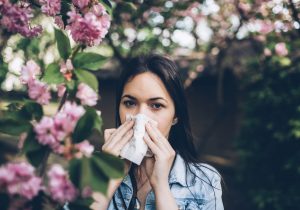
Is it COVID-19 or is it just seasonal allergies? Know the difference.
While allergies are nothing to sneeze at, COVID-19 is typically far worse. Still, they share many cold-like symptoms, from a runny nose to congestion and shortness of breath. If you’re one of the many who suffers during spring allergy season, it can be tough to tell if you’re facing a serious virus or just a case of seasonal sniffles. But by knowing whether the cause for concern is spring allergies or COVID-19, you can get the right relief. By discovering the difference between allergies vs. COVID-19, along with ways to protect yourself, you and your family will be able to breathe easy.
The season of sneezing
When spring is in the air, seasonal allergies should be on your radar. That’s because they’re triggered by pollen in the air, which is released by trees, grass, and weeds when they fertilize other plants. This happens most often during the warm months of spring and summer as trees and flowers begin to blossom. Once this pollen gets into the nose of someone who’s allergic, the immune system mistakes it for something dangerous and triggers a reaction that causes symptoms and suffering.
Signs of seasonal allergies
The medical term for seasonal allergies is allergic rhinitis, also known as hay fever. But, a fever isn’t one of the symptoms of spring allergies. However, there are plenty of other symptoms that are common to both COVID-19 and allergies. So how do you know if your springtime suffering is caused by allergies or COVID-19? With allergies, the common symptoms include:
- Runny nose
- Sneezing
- Watery, itchy, red eyes
- Nasal congestion
- Sinus pressure
- Shortness of breath
- Sore throat
- Wet cough
Signs of COVID-19
While there are many kinds of coronaviruses, COVID-19 is the one that’s led to the current pandemic. This highly contagious respiratory illness is caused by a newly discovered coronavirus that’s never been seen in people. Since the virus is easily spread from person to person, it has rapidly spread around the world and killed millions of people. While some sufferers experience only mild symptoms, COVID can also cause severe sickness or leave long-term side effects—and sometimes be fatal.
Since COVID-19 is new, questions about it are spreading as quickly as the virus itself. While public health officials are learning more every day, they’ve determined the common symptoms that most frequently signal an outbreak. But adding to the confusion is that the coronavirus shares several symptoms with seasonal allergies, which leaves many people wondering how to distinguish between allergies vs. COVID-19. Victims of the virus have reported many common symptoms, so if you experience any of them, you should be tested for it right away. According to medical experts and sufferers, the most common symptoms of COVID-19 include:
- Fever and chills
- Muscle or body aches
- Loss of taste or smell
- Headache
- Fatigue
- Stomach issues like nausea and diarrhea
- Shortness of breath
- Dry cough
- Sore throat
- Nasal congestion or runny nose
The differences between COVID-19 and allergies
While these conditions share several symptoms, they have just as many differences. The way to decipher the difference between COVID-19 and allergies is to ask yourself certain questions. Do you have a fever? If so, you may have COVID-19 since fever is one of the most frequent symptoms. If you have a cough, is it wet or dry? A wet cough typically comes from the post-nasal drip of seasonal allergies, while a dry cough is a common sign of COVID-19. And finally, are your eyes red and itchy? If so, then seasonal allergies are likely the source of your suffering.
How to thumb your nose at spring allergy season
With so much uncertainty in the air, the misery of spring allergies can easily be mistaken for COVID-19. If you’re truly in doubt, consider getting tested for the virus to put your mind and your nerves at ease. It’s also a good idea to take precautions to protect yourself against exposure to pollen. Try these helpful hints to nip allergies in the bud:
- Limit your outdoor exposure when pollen counts are high.
- Shower immediately after being outside.
- Avoid mowing the lawn or raking leaves.
- Give your home a spring cleaning to reduce any indoor allergy triggers.
- Talk to your SignatureMD-affiliated doctor about additional precautions and effective medications.
Ways to stay well ahead of COVID-19
With the virus and its variants spreading at a rapid rate, save yourself from suffering and slow the spread by taking the following precautions:
- Get a COVID-19 vaccine as soon as possible.
- Wear a mask to protect yourself and others.
- Stay at least six feet apart from people who don’t live with you.
- Avoid crowded areas and spaces with poor ventilation.
- Stay away from people who are sick.
- Keep washing your hands with soap and water for at least 20 seconds at a time.
- If soap and water aren’t available, use a hand sanitizer with at least 60% alcohol.
- Avoid touching your eyes, nose, and mouth.
- If you experience any symptoms of COVID-19, get tested right away.
When pollen season coincides with a pandemic, it can make you worry that every sneeze is a sign of COVID. Use this helpful guide to distinguish the difference and speak to your SignatureMD-affiliated doctor about surviving this season of uncertainty.